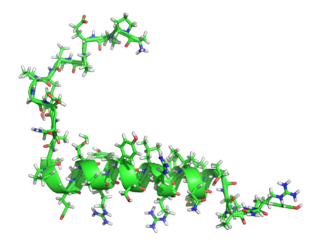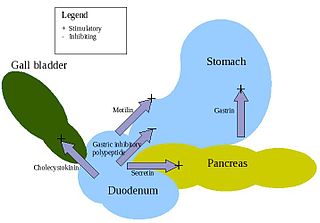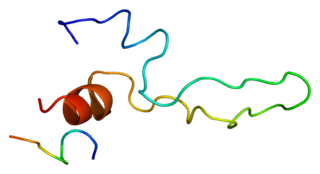Related Research Articles

Digestion is the breakdown of large insoluble food molecules into small water-soluble food molecules so that they can be absorbed into the watery blood plasma. In certain organisms, these smaller substances are absorbed through the small intestine into the blood stream. Digestion is a form of catabolism that is often divided into two processes based on how food is broken down: mechanical and chemical digestion. The term mechanical digestion refers to the physical breakdown of large pieces of food into smaller pieces which can subsequently be accessed by digestive enzymes. In chemical digestion, enzymes break down food into the small molecules the body can use.
Peptide hormones or protein hormones are hormones whose molecules are peptides or proteins, respectively. The latter have longer amino acid chain lengths than the former. These hormones have an effect on the endocrine system of animals, including humans. Most hormones can be classified as either amino acid–based hormones or steroid hormones. The former are water-soluble and act on the surface of target cells via second messengers; the latter, being lipid-soluble, move through the plasma membranes of target cells to act within their nuclei.

Cholecystokinin is a peptide hormone of the gastrointestinal system responsible for stimulating the digestion of fat and protein. Cholecystokinin, officially called pancreozymin, is synthesized and secreted by enteroendocrine cells in the duodenum, the first segment of the small intestine. Its presence causes the release of digestive enzymes and bile from the pancreas and gallbladder, respectively, and also acts as a hunger suppressant.

Gastrin is a peptide hormone that stimulates secretion of gastric acid (HCl) by the parietal cells of the stomach and aids in gastric motility. It is released by G cells in the pyloric antrum of the stomach, duodenum, and the pancreas.
Gastric acid, gastric juice, or stomach acid, is a digestive fluid formed within the stomach lining. Composed of hydrochloric acid, potassium chloride, and sodium chloride, gastric acid plays a key role in digestion of proteins by activating digestive enzymes, which together break down the long chains of amino acids of proteins. Gastric acid is regulated in feedback systems to increase production when needed, such as after a meal. Other cells in the stomach produce bicarbonate, a base, to buffer the fluid, ensuring a regulated pH. These cells also produce mucus – a viscous barrier to prevent gastric acid from damaging the stomach. The pancreas further produces large amounts of bicarbonate and secretes bicarbonate through the pancreatic duct to the duodenum to neutralize gastric acid passing into the digestive tract.

Parietal cells (also known as oxyntic or delomorphous cells) are the epithelial cells that secrete hydrochloric acid (HCl) and intrinsic factor. These cells are located in the gastric glands found in the lining of the fundus and in the cardia of the stomach. They contain an extensive secretory network (called canaliculi) from which the HCl is secreted by active transport into the stomach. The enzyme hydrogen potassium ATPase (H+/K+ ATPase) is unique to the parietal cells and transports the H+ against a concentration gradient of about 3 million to 1, which is the steepest ion gradient formed in the human body. Parietal cells are primarily regulated via histamine, acetylcholine and gastrin signaling from both central and local modulators (see 'Regulation')..
Cholecystokinin receptors or CCK receptors are a group of G-protein coupled receptors which bind the peptide hormones cholecystokinin (CCK) and gastrin. There are two different subtypes CCKA and CCKB which are ~50% homologous: Various cholecystokinin antagonists have been developed and are used in research, although the only drug of this class that has been widely marketed to date is the anti-ulcer drug proglumide.
Bombesin is a 14-amino acid peptide originally isolated from the skin of the European fire-bellied toad. It has two known homologs in mammals called neuromedin B and gastrin-releasing peptide. It stimulates gastrin release from G cells. It activates three different G-protein-coupled receptors known as BBR1, -2, and -3. It also activates these receptors in the brain. Together with cholecystokinin, it is the second major source of negative feedback signals that stop eating behaviour.
Digestive enzymes are a group of enzymes that break down polymeric macromolecules into their smaller building blocks, in order to facilitate their absorption by the body. Digestive enzymes are found in the digestive tracts of animals and in the tracts of carnivorous plants, where they aid in the digestion of food, as well as inside cells, especially in their lysosomes, where they function to maintain cellular survival. Digestive enzymes of diverse specificities are found in the saliva secreted by the salivary glands, in the secretions of cells lining the stomach, in the pancreatic juice secreted by pancreatic exocrine cells, and in the secretions of cells lining the small and large intestines.
Neuroendocrine cells are cells that receive neuronal input and, as a consequence of this input, release message molecules (hormones) into the blood. In this way they bring about an integration between the nervous system and the endocrine system, a process known as neuroendocrine integration. An example of a neuroendocrine cell is a cell of the adrenal medulla, which releases adrenaline to the blood. The adrenal medullary cells are controlled by the sympathetic division of the autonomic nervous system. These cells are modified postganglionic neurons. Autonomic nerve fibers lead directly to them from the central nervous system. The adrenal medullary hormones are kept in vesicles much in the same way neurotransmitters are kept in neuronal vesicles. Hormonal effects can last up to ten times longer than those of neurotransmitters. Sympathetic nerve fiber impulses stimulate the release of adrenal medullary hormones. In this way the sympathetic division of the autonomic nervous system and the medullary secretions function together.

Pancreatic polypeptide (PP) is a polypeptide secreted by PP cells in the endocrine pancreas predominantly in the head of the pancreas. It consists of 36 amino acids and has molecular weight about 4200 Da. The function of PP is to self-regulate pancreatic secretion activities. It also has effects on hepatic glycogen levels and gastrointestinal secretions.
Somatostatinomas are a tumor of the delta cells of the endocrine pancreas that produces somatostatin. Increased levels of somatostatin inhibit pancreatic hormones and gastrointestinal hormones. Thus somatostatinomas are associated with mild diabetes mellitus, steatorrhoea and gallstones, and achlorhydria. Somatostatinomas are commonly found in head of pancreas. Only ten percent of somatostatinomas are functional tumours [9], and 60-70% of tumours are malignant. Nearly two thirds of patients with malignant somatostatinomas will present with metastatic disease.
The gastrointestinal hormones constitute a group of hormones secreted by enteroendocrine cells in the stomach, pancreas, and small intestine that control various functions of the digestive organs. Later studies showed that most of the gut peptides, such as secretin, cholecystokinin or substance P, were found to play a role of neurotransmitters and neuromodulators in the central and peripheral nervous systems.

Enteroendocrine cells are specialized cells of the gastrointestinal tract and pancreas with endocrine function. They produce gastrointestinal hormones or peptides in response to various stimuli and release them into the bloodstream for systemic effect, diffuse them as local messengers, or transmit them to the enteric nervous system to activate nervous responses. Enteroendocrine cells of the intestine are the most numerous endocrine cells of the body. They constitute an enteric endocrine system as a subset of the endocrine system just as the enteric nervous system is a subset of the nervous system. In a sense they are known to act as chemoreceptors, initiating digestive actions and detecting harmful substances and initiating protective responses. Enteroendocrine cells are located in the stomach, in the intestine and in the pancreas.

The cholecystokinin B receptor also known as CCKBR or CCK2 is a protein that in humans is encoded by the CCKBR gene.

The Cholecystokinin A receptor is a human protein, also known as CCKAR or CCK1, with CCK1 now being the IUPHAR-recommended name.
A cholecystokinin antagonist is a specific type of receptor antagonist which blocks the receptor sites for the peptide hormone cholecystokinin (CCK).
The nervous system, and endocrine system collaborate in the digestive system to control gastric secretions, and motility associated with the movement of food throughout the gastrointestinal tract, including peristalsis, and segmentation contractions.
Local hormones are a large group of signaling molecules that do not circulate within the blood. Local hormones are produced by nerve and gland cells and bind to either neighboring cells or the same type of cell that produced them. Local hormones are activated and inactivated quickly. They are released during physical work and exercise. They mainly control smooth and vascular muscle dilation. Strength of response is dependent upon the concentration of receptors of target cell and the amount of ligand.
Hilda Tracy worked at University of Liverpool, UK, with Rod Gregory FRS to isolate and characterise the gastrointestinal hormone gastrin. She led the structure-function studies and had the first insight into gastrin's role in the clinical pathology of pancreatic Zollinger-Ellison tumours.
References
- ↑ Baldwin GS, Patel O, Shulkes A (February 2010). "Evolution of gastrointestinal hormones: the cholecystokinin/gastrin family". Current Opinion in Endocrinology, Diabetes and Obesity. 17 (1): 77–88. doi:10.1097/MED.0b013e328334e535. PMID 19952740. S2CID 25713886.
- ↑ Watson S, Arkinstall S (1994). "Cholecystokinin (CCK) and gastrin". The G-protein linked receptor factsbook. London: Academic Press. pp. 89–95. ISBN 978-0-12-738440-5.